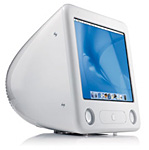Mac Musings
The New G4 Value Equation: eMac, iMac, and Power Mac
Daniel Knight - 2002.08.14 -
At Low End Mac, we're always concerned with computing value. Today we're asking how yesterday's announcements change the picture.
Consumer
The $100 price drop on the G4 iMacs obviously improve the value picture, bringing each model back to the prices announced in January.
But is the SuperDrive eMac really worth $400 more
than one with a Combo drive? Well, it's more than just replacing one
 media drive with another. Apple also boosts memory
from 128 MB to 256 MB and replaces the 40 GB hard drive with a 60 GB
unit. Still not quite enough to justify a $400 price hike.
media drive with another. Apple also boosts memory
from 128 MB to 256 MB and replaces the 40 GB hard drive with a 60 GB
unit. Still not quite enough to justify a $400 price hike.
Ah, but we almost overlooked one important detail - the SuperDrive eMac also has an 800 MHz G4 processor, giving it 15% more power than the 700 MHz model. That just about justifies the price increase.
By way of comparison, to get a G4 iMac with a SuperDrive, you have to spend $1,799. The eMac lacks the flat panel display of the G4 iMac, but otherwise pretty much matches it spec for spec. In that light, at $300 less than the SuperDrive iMac, the $1,499 eMac seems quite attractive.
Professional
Not only did Apple up the ante with the Power Mac G4 line, they also announced across-the-board price cuts on the Quicksilver 2002 models. Here's how the new and old compare after the price drops:
- Single 800 MHz, 256/40/Combo drive/Radeon 7000, $1,299
- Single 933 MHz, 256/60/SuperDrive/GeForce 4 MX, $1,499
- Dual 1 GHz, 512/80/SuperDrive/GeForce 4 MX, $2,199
- Dual 867 MHz, 256/60/Combo drive/GeForce 4 MX, $1,699
- Dual 1 GHz, 256/80/SuperDrive, Radeon 9000 Pro, $2,499
- Dual 1.25 GHz, 512/120/SuperDrive, Radeon 9000 Pro, $3,299
Best Low Price G4
Although the G4/800 is the most affordable of the bunch, the real
value is the G4/933 with a 17% faster CPU, a SuperDrive, and a GeForce
video card at $1,499. This would be an excellent machine for  anyone, but especially those who are
sticking with OS 9 for the time being, since that OS doesn't take
advantage of the second CPU in the higher priced models.
anyone, but especially those who are
sticking with OS 9 for the time being, since that OS doesn't take
advantage of the second CPU in the higher priced models.
It's also the best way to get a SuperDrive model without spending over $2,000.
Best Choice in the Middle
Comparing the older dual 1 GHz model with the new 867 MHz model points out some differences:
Quicksilver 2002 is least costly dual processor model with a SuperDrive from the factory, but you can have a dual 867 built to order with a SuperDrive for $1,899. The 15% difference in CPU speed corresponds with a roughly 15% difference in cost.
But the new Power Mac G4 (DDR) has other advantages - two optical drive bays (so you can have a second DVD, Combo, CD, or SuperDrive to really simplify copying) and the ability to handle 2 GB of RAM, just in case 1.5 GB isn't enough.
All things are not quite equal between them. If you're still booting into OS 9, pick the older model, but otherwise the dual 867 seems to offer the better value with more expansion options, a lower price, and a minimal difference in speed.
Comparing the new and old 1 GHz models at $300 difference, the faster memory bus (167 MHz vs. 133 MHz - and the use of DDR memory) gives the new model an edge, as do the extra optical drive bay, room for more RAM, and use of the Radeon 9000 Pro video card. Worth $300? That's a toughie.
At the Top
The new G4/1.25 GHz retails for $300 more than the old G4/1.0 GHz model did (before the price drop). It will ship in September, and offers 25% more CPU power, faster memory (DDR on a 167 MHz bus), room for more RAM, and space for two optical drives.
In that respect, it's a real value. But compared with the new dual 1 GHz model, all you gain is more CPU horsepower, an additional 256 MB of RAM, and 40 GB more hard drive space. Unless you really need the speed, the $600 premium seems a bit steep. If you do need top-end performance, you'll pay a 32% higher price to get 20% more computing speed. (Yes, the CPU is 25% faster, but that only translates to running 20% faster. Do the math if you don't believe me.)
For value, the new G4 dual 1 GHz seems to hit the sweet spot. Of course, you'll need to weigh your needs, your wants, and your budget to decide which is best for you.
The best thing about the 1.25 GHz model is the knowledge that Motorola is finally keeping up with Moore's Law. That bodes well for the future. If they can keep this up, we should oughta see a 1.5-1.6 GHz model at the top of the Power Mac line in January.
That's assuming no G5 from Motorola or an Apple decision to adopt IBM's new CPU based on the Power4 architecture. After all, now that all the Power Macs are dual processor models, the dual-core IBM looks more attractive than ever.